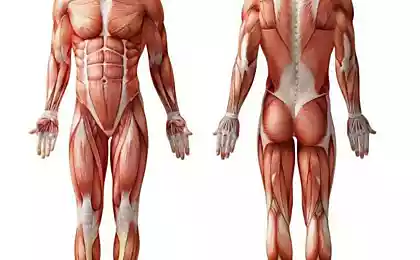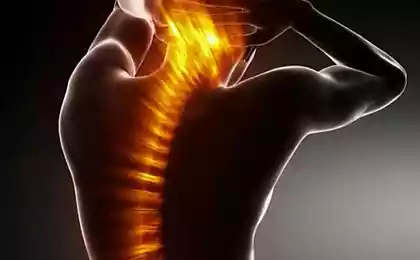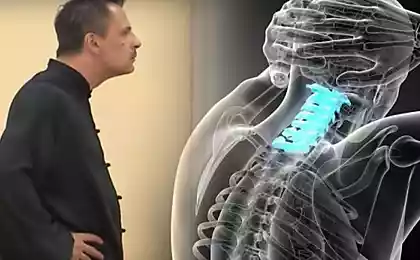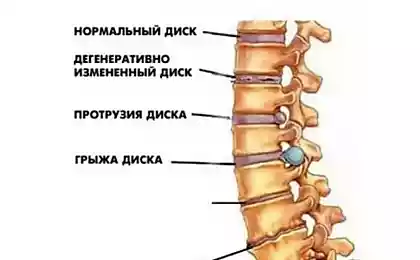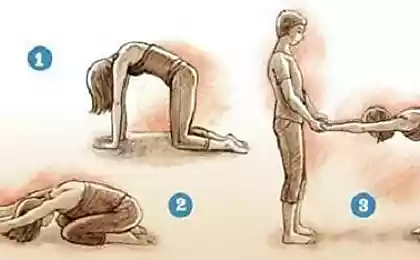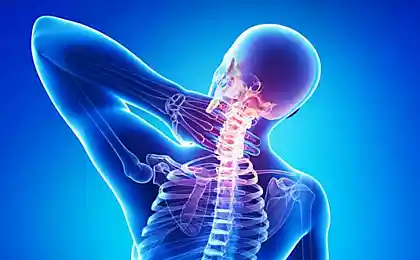551
Effective exercises in diseases of the cervical spine
Among middle and older age is rather widespread disease of the cervical spine. Those who have the disease is not so serious, suffering pain and immobility of the head, neck, shoulders, forearms or hands, and in serious cases, possible muscle atrophy, paralysis.
Among the external factors that cause disease of the cervical spine, the wind, cold, dampness or pathogens that causes stagnation of qi (vital energy) and blood. Internal contributing factors include the gradual weakening of the liver and kidneys, accompanied by deterioration of muscles and bones.

Treatment of diseases of the cervical spine by means of traditional Chinese medicine includes, in addition to the internal and local application of drugs, therapeutic pressure, self-massage and remedial gymnastics, helping to expand the space between the vertebrae, increase mobility in the cervical spine, reduce pressure on nerves and thus relieve tension and muscle spasm, improve blood circulation and metabolism in the bones, the elasticity of the ligaments of the muscles related to the cervical spine.
The following treatments are recommended for middle-aged and elderly suffering from diseases of the cervical spine. Those who do not have such diseases, you may apply these techniques as a preventive measure.
THERAPEUTIC PRESSURE AT POPULARNOSTI, IMMOBILITY AND PAIN IN THE HANDS
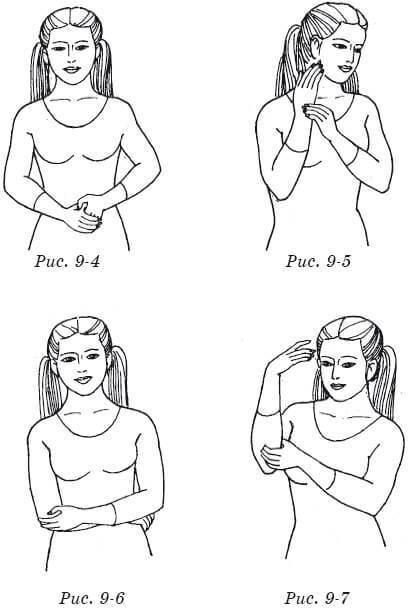
1. Push down with your thumb on the point Hae-GU on the affected side for 30 seconds (Fig. 9-4).
2. Push down with thumb and middle finger on the point of Yang Chi with a sore hand for 30 seconds (Fig. 9-5).
3. Knock and poke your thumb to the point qu Chi on the affected side for 30 seconds (Fig. 9-6).
4. Knock and poke your index and middle fingers to the point Shao Hai on the sick side for 30 seconds (Fig. 9-7).
5. Slowly apply pressure with thumb and middle finger on the point que-pan with a sore hand for 1 minute (Fig. 9-8).
6. Press the index, middle and ring fingers to the point Jian-Jing with a sore hand for 1 minute (Fig. 9-9).
7. Knock and poke your index and middle fingers to the point Feng-Chi on the affected side for 1 minute (Fig. 9-10).
8. Push your middle finger on the point of WAN-GU with a sore hand for 1 minute (Fig. 9-11).

SELF-MASSAGE NECK
1. First gently massage the index, middle, ring fingers and little finger muscles on the affected side of the neck from the top down, then with both hands massage the muscles on both sides of the neck for 1-2 minutes.
2. Slowly poke the index, middle and ring fingers of the healthy hand muscles on the affected side to the midline of the neck for 2 minutes and then do the same on the muscles of the healthy side of the same finger of the other hand, but for 1 minute.
3. Cross your fingers behind the neck, and bases of the palms to capture and retract the muscles of the cervical for 1 minute.
4. Grab and knead the hand of the affected side from the shoulder to the wrist all the fingers of his healthy hand again and again for 2 minutes.
THERAPEUTIC EXERCISES FOR THE NECK
Starting position: stand straight, feet naturally positioned at shoulder width, hands on waist. Older and physically impaired people can take a sitting position.
Exercise 1. Slowly bend your neck forward to touch the chin chest and back. Repeat for 1-2 minutes.
Exercise 2. Slowly and repeatedly turn your head first to the healthy side, and then the patient (like look the left then to the right). Perform 1-2 minutes.
Exercise 3. Bend the neck first, in a healthy way, and then to the patient. Repeat as 1-2 minutes.
Exercise 4. Slowly turn your head first in a healthy way, and then to the patient. Repeat for 1-2 minutes.
Exercise 5. Slowly turn the head obliquely forward and down in a healthy way, and then to the patient. Repeat the exercise for 1 minute (as if looking around in search of something).
Exercise 6. Slowly turn the head obliquely backward and downward in a healthy way, and then to the patient. Repeat the exercise for 1 minute.
Exercise 7. Slowly turn the head obliquely forward and upward in a healthy way, and then to the patient.
Repeat the exercise for 1-2 minutes (like looking at distant high mountains).
Exercise 8. Slowly turn the head obliquely backwards and upwards in a healthy way, and then to the patient. Repeat the exercise for 1-2 minutes.
WHAT YOU SHOULD PAY ATTENTION:
1. Force gentle exercises patiently and methodically. Avoid applying too much force.
2. The time and number of repetitions should be selected individually. As a General comment, we emphasize that seriously ill people should do the training sessions short, increasing the number of exercises and repetitions as recovery.
3. Perform exercises diligently and persistently.
4. Exercise is contraindicated in those with fractures of the cervical, bias, tuberculosis or bone hyperplasia of the cervical vertebrae, strongly perezhimaya spinal cord and vertebral artery, and a severe form of hypertension.
Exercises developing thin muscle fibers of the spine
How to improve your appearance — 10 simple tips
What you should pay attention to suffering from diseases of the cervical spine:
1. Should not be too long to write or read.
2. Pillow for sleeping should be neither too high nor too low.
3. Keep your neck warm, avoid wind, cold and dampness.
4. Do not turn your head too much.
5. Do not load weight on the shoulders.
6. Be careful when walking to avoid injury from possible falls. published
"Therapeutic exercise Chinese medicine", sung Zindani, Liu Dozen
Source: vk.com/wall-23903469?w=wall-23903469_6269
Among the external factors that cause disease of the cervical spine, the wind, cold, dampness or pathogens that causes stagnation of qi (vital energy) and blood. Internal contributing factors include the gradual weakening of the liver and kidneys, accompanied by deterioration of muscles and bones.

Treatment of diseases of the cervical spine by means of traditional Chinese medicine includes, in addition to the internal and local application of drugs, therapeutic pressure, self-massage and remedial gymnastics, helping to expand the space between the vertebrae, increase mobility in the cervical spine, reduce pressure on nerves and thus relieve tension and muscle spasm, improve blood circulation and metabolism in the bones, the elasticity of the ligaments of the muscles related to the cervical spine.
The following treatments are recommended for middle-aged and elderly suffering from diseases of the cervical spine. Those who do not have such diseases, you may apply these techniques as a preventive measure.
THERAPEUTIC PRESSURE AT POPULARNOSTI, IMMOBILITY AND PAIN IN THE HANDS

1. Push down with your thumb on the point Hae-GU on the affected side for 30 seconds (Fig. 9-4).
2. Push down with thumb and middle finger on the point of Yang Chi with a sore hand for 30 seconds (Fig. 9-5).
3. Knock and poke your thumb to the point qu Chi on the affected side for 30 seconds (Fig. 9-6).
4. Knock and poke your index and middle fingers to the point Shao Hai on the sick side for 30 seconds (Fig. 9-7).
5. Slowly apply pressure with thumb and middle finger on the point que-pan with a sore hand for 1 minute (Fig. 9-8).
6. Press the index, middle and ring fingers to the point Jian-Jing with a sore hand for 1 minute (Fig. 9-9).
7. Knock and poke your index and middle fingers to the point Feng-Chi on the affected side for 1 minute (Fig. 9-10).
8. Push your middle finger on the point of WAN-GU with a sore hand for 1 minute (Fig. 9-11).

SELF-MASSAGE NECK
1. First gently massage the index, middle, ring fingers and little finger muscles on the affected side of the neck from the top down, then with both hands massage the muscles on both sides of the neck for 1-2 minutes.
2. Slowly poke the index, middle and ring fingers of the healthy hand muscles on the affected side to the midline of the neck for 2 minutes and then do the same on the muscles of the healthy side of the same finger of the other hand, but for 1 minute.
3. Cross your fingers behind the neck, and bases of the palms to capture and retract the muscles of the cervical for 1 minute.
4. Grab and knead the hand of the affected side from the shoulder to the wrist all the fingers of his healthy hand again and again for 2 minutes.
THERAPEUTIC EXERCISES FOR THE NECK
Starting position: stand straight, feet naturally positioned at shoulder width, hands on waist. Older and physically impaired people can take a sitting position.
Exercise 1. Slowly bend your neck forward to touch the chin chest and back. Repeat for 1-2 minutes.
Exercise 2. Slowly and repeatedly turn your head first to the healthy side, and then the patient (like look the left then to the right). Perform 1-2 minutes.
Exercise 3. Bend the neck first, in a healthy way, and then to the patient. Repeat as 1-2 minutes.
Exercise 4. Slowly turn your head first in a healthy way, and then to the patient. Repeat for 1-2 minutes.
Exercise 5. Slowly turn the head obliquely forward and down in a healthy way, and then to the patient. Repeat the exercise for 1 minute (as if looking around in search of something).
Exercise 6. Slowly turn the head obliquely backward and downward in a healthy way, and then to the patient. Repeat the exercise for 1 minute.
Exercise 7. Slowly turn the head obliquely forward and upward in a healthy way, and then to the patient.
Repeat the exercise for 1-2 minutes (like looking at distant high mountains).
Exercise 8. Slowly turn the head obliquely backwards and upwards in a healthy way, and then to the patient. Repeat the exercise for 1-2 minutes.
WHAT YOU SHOULD PAY ATTENTION:
1. Force gentle exercises patiently and methodically. Avoid applying too much force.
2. The time and number of repetitions should be selected individually. As a General comment, we emphasize that seriously ill people should do the training sessions short, increasing the number of exercises and repetitions as recovery.
3. Perform exercises diligently and persistently.
4. Exercise is contraindicated in those with fractures of the cervical, bias, tuberculosis or bone hyperplasia of the cervical vertebrae, strongly perezhimaya spinal cord and vertebral artery, and a severe form of hypertension.
Exercises developing thin muscle fibers of the spine
How to improve your appearance — 10 simple tips
What you should pay attention to suffering from diseases of the cervical spine:
1. Should not be too long to write or read.
2. Pillow for sleeping should be neither too high nor too low.
3. Keep your neck warm, avoid wind, cold and dampness.
4. Do not turn your head too much.
5. Do not load weight on the shoulders.
6. Be careful when walking to avoid injury from possible falls. published
"Therapeutic exercise Chinese medicine", sung Zindani, Liu Dozen
Source: vk.com/wall-23903469?w=wall-23903469_6269





